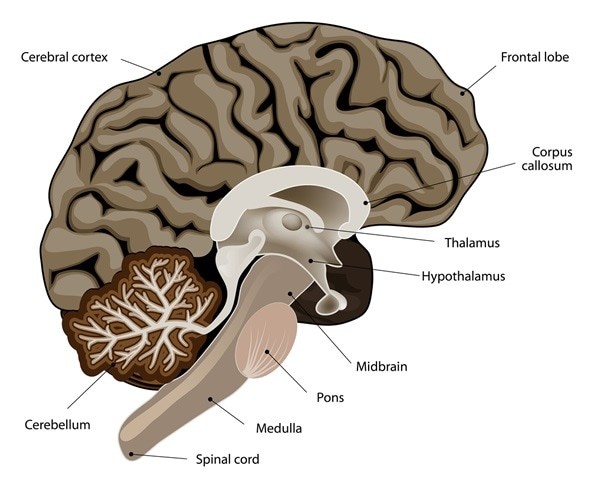The thalamus, often referred to as the dorsal thalamus, is a crucial component of the diencephalon, a region deep within the brain that also encompasses the epithalamus, ventral thalamus, and subthalamic thalamus. Think of the thalamus as a central hub, strategically positioned to manage and distribute a vast amount of information flowing through the brain.
 Vertical section of a human brain highlighting the thalamus, hypothalamus, midbrain, and other structures.
Vertical section of a human brain highlighting the thalamus, hypothalamus, midbrain, and other structures.
The primary role of the thalamus is to act as a relay station for sensory and motor signals. It receives sensory information from all over the body and channels it to the cerebral cortex for higher-level processing. Imagine it as a sophisticated switchboard operator, directing incoming calls (sensory inputs) to the correct departments (cortical areas) for interpretation and response. This function is so vital that the thalamus processes a staggering 98% of all sensory input, with the exception of olfaction (smell).
The Thalamus: Your Brain’s Information Hub
Experts often describe the thalamus as a “gatekeeper” or “filter” for information. This analogy highlights its ability to selectively modulate the flow of information to the cortex. Not all sensory input is created equal, and the thalamus plays a critical role in prioritizing and filtering information based on importance and relevance. Specific neurons within the thalamus are capable of adjusting their activity to fine-tune this information transfer, ensuring that the cerebral cortex is not overwhelmed with irrelevant data. This filtering process is essential for focus, attention, and preventing sensory overload.
Key Roles of Thalamic Nuclei
The thalamus is not a uniform structure; it is composed of distinct groups of nerve cells, known as nuclei, each with specialized functions. These nuclei can be broadly categorized into three main groups:
Sensory Relay Nuclei: The Primary Sensory Pathways
These nuclei are the direct pathways for sensory information traveling to the cerebral cortex. Key examples include:
- Ventral Posterior Nucleus: This nucleus is responsible for relaying somatosensory information, such as touch, pain, temperature, pressure, and proprioception (body position), to the somatosensory cortex.
- Lateral Geniculate Body: A crucial part of the visual pathway, this nucleus receives input from the optic tract (carrying information from the eyes) and projects it to the primary visual cortex in the occipital lobe, enabling sight.
- Medial Geniculate Body: This nucleus serves as the auditory relay, receiving information from the inferior colliculus in the midbrain and transmitting it to the primary auditory cortex, which is essential for hearing.
Association Nuclei: Integrating Cortical Information
These nuclei are more complex, receiving input from specific areas of the cerebral cortex and then projecting back to association areas within the cortex. Their role is thought to be in regulating and modulating activity within these association areas, which are involved in higher-level cognitive functions.
Non-Specific Nuclei: Modulating Brain Activity
This group includes the intralaminar and midline thalamic nuclei. They receive input from the cortex and project information diffusely throughout it. These nuclei are believed to play a broader role in modulating overall brain activity, influencing functions like alertness, arousal, and consciousness by facilitating communication between different brain regions.
The Thalamus and Sensory Systems in Detail
Let’s look closer at how the thalamus functions within specific sensory systems:
-
Visual System: Light information captured by the retina is converted into electrical signals and transmitted via the optic nerve. These signals reach the lateral geniculate nucleus (LGN) in the thalamus. The LGN not only relays this information to the primary visual cortex (V1) in the occipital lobe but also processes and modulates it. This thalamo-cortical loop, where the cortex sends feedback to the thalamus, is a common feature of sensory processing.
-
Auditory System: Sound waves are processed by the ear and converted into neural signals. These signals travel through the brainstem to the inferior colliculus in the midbrain and then to the medial geniculate nucleus (MGN) of the thalamus. The MGN relays this auditory information to the primary auditory cortex, allowing us to perceive sounds.
-
Somatosensory System: Sensory receptors throughout the body detect touch, pressure, pain, temperature, and body position. This information is transmitted to the spinal cord and brainstem, eventually reaching the ventral posterior nuclei (VPN) of the thalamus. The VPN then relays this somatosensory information to the primary somatosensory cortex, allowing us to experience these sensations.
The Thalamus: Beyond Sensory Relay – Consciousness and Arousal
While primarily known for its sensory relay functions, the thalamus’s role extends to higher-level brain functions, particularly consciousness and arousal. The thalamic nuclei are strongly interconnected with the cerebral cortex, forming complex thalamo-cortico-thalamic circuits. These circuits are thought to be crucial for regulating consciousness, wakefulness, and alertness. Damage to the thalamus can have severe consequences, including a significantly increased risk of coma, highlighting its vital role in maintaining consciousness.
In summary, the thalamus is much more than a simple relay station. It is a sophisticated information processing hub, filtering, modulating, and distributing sensory and motor signals, and playing a critical role in our perception, awareness, and overall brain function.
Sources
- [Original article URL (if available)]
- [Neuroscience textbooks/reputable online resources on the thalamus]
Further Reading
- [Advanced neuroscience articles on thalamic function]